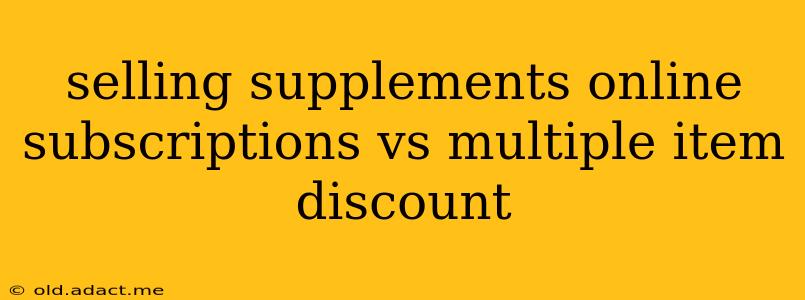The online supplement market is booming, and for good reason. Consumers are increasingly focused on health and wellness, seeking convenient ways to incorporate supplements into their routines. But for businesses, the question remains: which sales strategy will drive the most revenue – subscription services or multiple-item discounts? Both offer unique advantages and disadvantages, and the best choice depends heavily on your target audience, product offerings, and overall business goals. This comprehensive guide will dissect both approaches, helping you determine the optimal strategy for your supplement business.
Understanding the Subscription Model
Subscription services offer customers a recurring delivery of their chosen supplements at regular intervals. This creates a predictable revenue stream for businesses and provides customers with convenience and consistency.
Pros of Subscription Models:
- Predictable Revenue: Recurring revenue allows for better financial planning and forecasting.
- Increased Customer Loyalty: Regular deliveries foster a sense of loyalty and build a stronger customer relationship.
- Higher Average Order Value (AOV): Subscriptions often encourage customers to purchase more products over time.
- Reduced Marketing Costs: Retention marketing is generally less expensive than acquiring new customers.
- Valuable Customer Data: Subscription models provide valuable data on customer preferences and purchasing habits.
Cons of Subscription Models:
- Higher Initial Investment: Setting up a robust subscription system requires investment in technology and infrastructure.
- Customer Churn: Managing customer churn is crucial; losing subscribers can significantly impact revenue.
- Inventory Management Complexity: Accurate forecasting of demand is crucial to avoid stockouts or overstocking.
- Potential for Customer Dissatisfaction: Customers might feel locked into a commitment if they're unhappy with the product or service.
The Allure of Multiple Item Discounts
Multiple item discounts incentivize customers to purchase more products at once by offering a reduced price for bulk purchases. This is a classic retail strategy, and it works well in the supplement industry.
Pros of Multiple Item Discounts:
- Increased Sales Volume: Customers are more likely to buy more products when offered a discount.
- Clear and Simple: The pricing structure is easy for customers to understand.
- Immediate Gratification: Customers receive the discount immediately, unlike subscriptions.
- Lower Marketing Costs (Potentially): Simple promotions can be highly effective.
Cons of Multiple Item Discounts:
- Less Predictable Revenue: Sales fluctuate depending on promotional periods.
- Lower Customer Loyalty: Customers might not return after a single purchase.
- Potential for Reduced Profit Margins: Discounts can impact profitability if not managed carefully.
- Increased Inventory Risk: Having a large stock of discounted products ties up capital.
Which Strategy Is Right for Your Supplement Business?
The optimal strategy depends on several factors:
- Target Audience: Are your customers looking for convenience and consistency (subscriptions) or value and immediate savings (discounts)? Younger demographics may lean towards subscriptions for convenience, while older generations may value the immediate savings.
- Product Type: Some supplements are better suited for subscriptions (daily vitamins) than others (occasional use products).
- Pricing Strategy: Subscription models often benefit from higher-priced products, while discounts work better with products that have a lower price point.
- Marketing Capabilities: Managing subscriptions requires more sophisticated marketing and customer relationship management (CRM) systems.
- Business Goals: Are you prioritizing predictable revenue or rapid growth?
Frequently Asked Questions (FAQ)
H2: Can I combine subscription and discount models?
Yes! Many businesses successfully combine both. For example, you might offer a subscription discount or a bulk discount on top of a subscription. This offers flexibility and caters to a wider range of customer preferences.
H2: How do I manage subscription cancellations and refunds?
Having a clear and transparent cancellation policy is crucial. Ensure your system allows for easy cancellations and that your refund policy is straightforward. Proactive communication with customers can help reduce churn.
H2: What are the legal implications of subscription services?
Familiarize yourself with relevant consumer protection laws in your region regarding automatic renewals and cancellation policies. Transparency is key to avoiding legal issues.
H2: How do I choose the right subscription platform?
Research different platforms that cater to the needs of your business. Consider factors like ease of use, integration with your existing systems, and customer support.
In conclusion, there's no one-size-fits-all answer. Careful consideration of your target market, products, and business goals is vital in choosing between a subscription model, multiple item discounts, or a hybrid approach. By understanding the pros and cons of each, you can make an informed decision that maximizes your revenue and builds a loyal customer base. Remember to always prioritize transparency and customer satisfaction, regardless of the chosen sales strategy.
